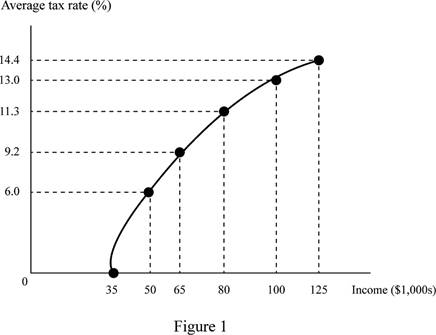
Calculate the average tax rate and identify the tax in nature.
Explanation of Solution
The average tax rate can be calculated by using formula as follows:
Substitute the respective values in Equation (1) to calculate the average tax rate for the total income $35,000 as shown below:
The average tax rate for the total income $35,000 is 0.
Table-1 shows the values of the average tax rate for different income groups obtained by using Equation (1).
Table-1
| Total income |
Average tax rate |
|
$50,000 |
6.0% |
|
$65,000 |
9.2% |
|
$80,000 |
11.3% |
|
$ 100,000 |
13.0% |
|
$125,000 |
14.4% |
From table-1, it is clear that the tax is progressive in nature. There is no tax for the first $35,000. When the income rises, the tax rate also rises.
Figure-1 represents the graphical representation of the average tax rate of these different income levels.

In figure-1, the horizontal axis shows the income levels and the vertical axis shows the average tax rate. When the income rises the average tax rate also rises. Therefore the tax is progressive in nature.
Progressive tax: The progressive tax refers to the higher income people paying a higher tax amount than the lower income people.
Want to see more full solutions like this?
Chapter 19 Solutions
Principles of Microeconomics (12th Edition)
- Answerarrow_forwardM” method Given the following model, solve by the method of “M”. (see image)arrow_forwardAs indicated in the attached image, U.S. earnings for high- and low-skill workers as measured by educational attainment began diverging in the 1980s. The remaining questions in this problem set use the model for the labor market developed in class to walk through potential explanations for this trend. 1. Assume that there are just two types of workers, low- and high-skill. As a result, there are two labor markets: supply and demand for low-skill workers and supply and demand for high-skill workers. Using two carefully drawn labor-market figures, show that an increase in the demand for high skill workers can explain an increase in the relative wage of high-skill workers. 2. Using the same assumptions as in the previous question, use two carefully drawn labor-market figures to show that an increase in the supply of low-skill workers can explain an increase in the relative wage of high-skill workers.arrow_forward
- Published in 1980, the book Free to Choose discusses how economists Milton Friedman and Rose Friedman proposed a one-sided view of the benefits of a voucher system. However, there are other economists who disagree about the potential effects of a voucher system.arrow_forwardThe following diagram illustrates the demand and marginal revenue curves facing a monopoly in an industry with no economies or diseconomies of scale. In the short and long run, MC = ATC. a. Calculate the values of profit, consumer surplus, and deadweight loss, and illustrate these on the graph. b. Repeat the calculations in part a, but now assume the monopoly is able to practice perfect price discrimination.arrow_forwardThe projects under the 'Build, Build, Build' program: how these projects improve connectivity and ease of doing business in the Philippines?arrow_forward
 Economics (MindTap Course List)EconomicsISBN:9781337617383Author:Roger A. ArnoldPublisher:Cengage Learning
Economics (MindTap Course List)EconomicsISBN:9781337617383Author:Roger A. ArnoldPublisher:Cengage Learning









